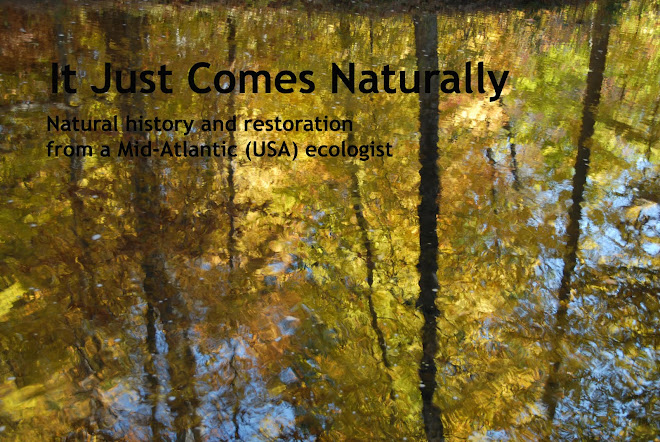 |
| Porcelain-berry, the kudzu of the North, on the periphery of my natural area |
 |
| Porcelain-berry fruits in varying stages of ripeness |
Once the plant escaped the bounds of gardens (undoubtedly aided by birds that eat its fruit and then defecate the seeds elsewhere), it found a perfect home in the Mid-Atlantic. It grows up into the canopy, spreads out to capture sunlight, and blankets the trees supporting it, eventually shading the trees to death or ripping off their limbs when the weight of the vines becomes too much for the tree to bear, especially when covered in snow and ice in the winter.
 |
| Porcelain-berry flowers attracting a honeybee |
The only insects I have ever observed damaging porcelain-berry leaves are invasive, non-native Japanese beetles, but they never become numerous enough to inflict real harm to the plant. I suspect that even if the plant has a specific disease or insect pest that keeps it in check in its homeland, such a disease or insect could never be imported into the United States as a biocontrol agent because it likely would also attack commercial grapes.
 |
| A porcelain-berry rhizome |
One of my board members asked me to do a photographic inventory of land parcels on the periphery of the preserve that we might be able to acquire to add to the natural area. I completed the inventory and prepared a PowerPoint program that I presented at the last board meeting. In my remarks prefacing the presentation, I alerted the board members to note that every single one of the 10 parcels I had photographed that was not maintained as a meadow was completely overwhelmed by porcelain-berry. The Vandals are at the gates, and the endgame doesn't look good.
Porcelain-berry is really bringing me down; it's the last straw. I have psychically and physically invested nearly half my life in the stewardship of my natural area preserve and, if anything, it is in worse condition now than when I started working. Storm-water flooding is worse, streambank erosion is worse, white-tailed deer damage is stable but is not declining, the invasive non-native emerald ash borer is on our doorstep and will kill perhaps a third the trees in the preserve, and porcelain-berry (and other invasive vines) are, if anything, even more prolific than they were a quarter-century ago. If I haven't already crossed the threshold, I'm close to the point of despairing about my professional career.






